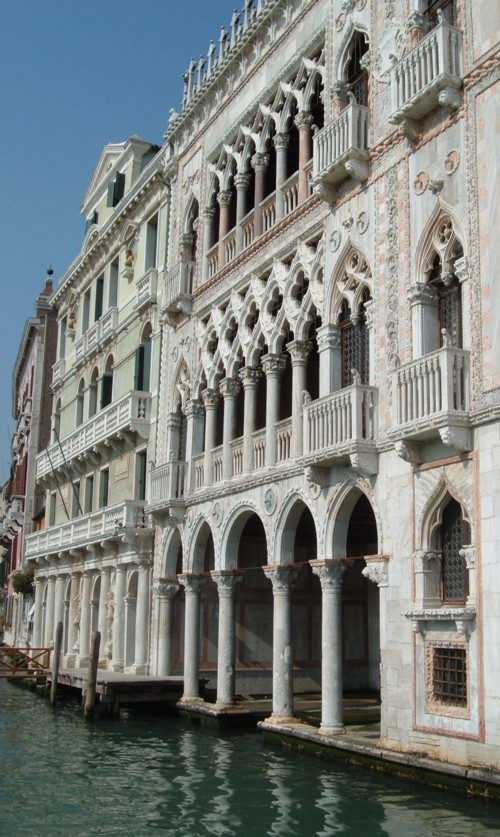The Ca’ d’Oro is the most celebrated palazzo on the Grand Canal; a fabulous Gothic palace which used to gleam with gold. Nowadays it houses a small art museum, but just as good as the art is the opportunity to admire the lovely courtyard and to stand on the loggia above the Grand Canal.
If you’re on a short break and don’t feel you have time to dive into one of Venice’s major museums, the Ca’ d’Oro offers a good taste of the city’s art and architecture, and doesn’t take very long to look around.
History
Ca’, short for ‘casa’ (house) is what all Venice’s grand buildings were called once, when the title ‘palazzo’ belonged only to the Ducal Palace. Ca’ d’Oro means ‘House of Gold’, and this building was once famed for its decorated and gilded façade. Even now this has worn away, it is still a breathtaking sight.
The Ca’ d’Oro was built between 1420 and 1434 for a rich Venetian, Marino Contarini. In her invaluable guide The Architectural History of Venice, Deborah Howard suggests that the building was in part a memorial to his first wife, whose family had owned the palace previously on the site, architectural fragments of which were carefully incorporated into the new building.
Two teams of stonemasons worked on the construction, one headed by Matteo Raverti from Milan and the other by local Venetian Giovanni Bon. The building is clad in a variety of white and coloured marbles, with one of the most elaborate façades you’ll ever see. As Contarini must have intended, the building would have staggered his fellow Venetians, not least because of the extravagance of its coloured decoration: gilding on the window traceries and carvings, ultramarine paint and varnished red Verona marble.
Like the other older palaces along the canal, the Ca’ d’Oro is now noticeably low in the water, the waterline having risen considerably in intervening centuries. At high tide, water laps between the entrance columns.
In the nineteenth century the building was presented to the ballerina Marie Taglioni, who set about gutting the building. Ruskin was visiting Venice at the time, and he sat and mourned as the palace’s original features were ripped out and discarded in front of him. Later the building was bought by Baron Giorgio Franchetti, an art collector, who restored as much as possible and then left the building to the Italian state, along with his art collection.

Galleria Franchetti
The Galleria Franchetti, based around the Baron’s art collection, has an interesting range of exhibits. The greatest masterpiece on display is Andrea Mantegna’s St. Sebastian. Other highlights of the collection are paintings by Vittore Carpaccio, including an Annunciation and a sculpted Double Portrait by Tullio Lombardo. If you have visited Rome, you’ll be interested to see Bernini’s clay models for his statues around the fountains of Piazza Navona. Some faded fragments of fresco on display are by Titian and Giorgione; they come from the exterior of the Fondaco dei Tedeschi, close to the Rialto.
Don’t miss the courtyard, which is accessed from the ground floor entrance hall. It is an absolutely exquisite space with Moorish influences, mosaic flooring, aged columns and the original well-head, sold off by Taglioni and re-acquired by Baron Franchetti.
Visiting information
The Ca’ d’Oro is in the Cannaregio district. Its land entrance is an unobtrusive doorway in the alley between the Ca’ d’Oro waterbus stop (line 1) and the busy Strada Nova.
The gallery is open from 8:15am, making it a good destination for the early-rising tourist. On Mondays it closes at 2pm, other days it’s open until 7:15pm. There’s an admission charge: check the latest costs and opening times on the website (below). You can also get a combined ticket with Venice’s other state museums: the Accademia and the Museo Orientale. There’s a little shop in the building selling art books and postcards.
On this site
More Venice tourist attractions
Useful external links
